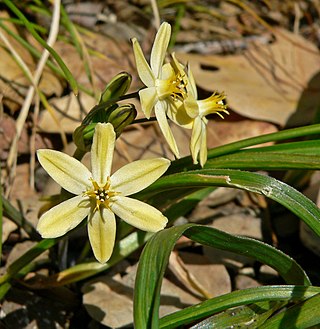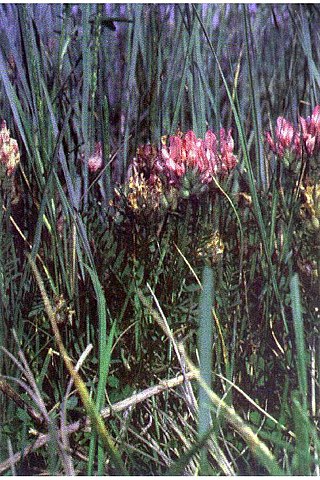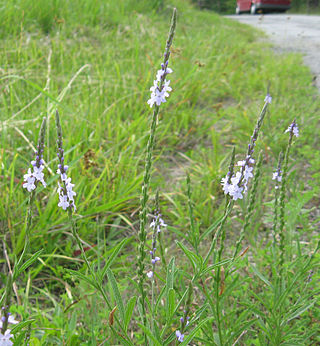
Triteleia is a genus of monocotyledon flowering plants also known as triplet lilies. The 16 species are native to western North America, from British Columbia south to California and east to Wyoming and Arizona, with one species in northwestern Mexico. However, they are most common in California. They are perennial plants growing from a fibrous corm roughly spherical in shape. They get their name from the fact that all parts of their flowers come in threes.

Aesculus californica, commonly known as the California buckeye or California horse-chestnut, is a species of buckeye native to California and southwestern Oregon.

Iberis sempervirens, the evergreen candytuft or perennial candytuft, is a species of flowering plant in the family Brassicaceae, native to southern Europe. The species is often used as an ornamental garden shrub because of its decorative flowers. Iberis is so named because many members of the genus come from the Iberian Peninsula in south west Europe. Sempervirens means "always green", referring to the evergreen foliage.

Rudbeckia fulgida, the orange coneflower or perennial coneflower, is a species of flowering plant in the family Asteraceae, native to eastern North America.

The triplet lily Triteleia bridgesii is known by the common name Bridges' brodiaea. It is found in the foothills and low elevation mountains of California and Oregon, often in areas of serpentine soil.

Triteleia laxa is a triplet lily known by several common names, including Ithuriel's spear, common triteleia and grassnut. It is native to California where it is a common wildflower, and it is occasionally found in southwestern Oregon. It bears a tall, naked stem topped with a spray of smaller stalks, each ending in a purple or blue flower. The flower is tubular, opening into a sharply six-pointed star. The plant grows from a corm which is edible and similar in taste and use as the potato. The most used common name for the species, Ithuriel's spear, is a reference to the angel Ithuriel from Milton's Paradise Lost.

Triteleia lugens, the Coast Range triteleia or dark-mouthed triteleia, is a monocot flowering plant in the genus Triteleia. It is endemic to California, where it is known from the Coast Ranges north and south of the San Francisco Bay Area. Its habitat includes forests and chaparral.

Triteleia ixioides, known as prettyface or golden star, is a monocotyledon flowering plant in the genus Triteleia. It is native to northern and central California and southwestern Oregon, where it can be found in coastal and inland coniferous forests and other habitat. It is a perennial wildflower growing from a corm. It produces one to two basal leaves up to 50 centimeters long by 1.5 wide. The inflorescence arises on an erect stem up to 80 centimeters tall. It is an umbel-like cluster of several flowers each borne on a pedicel up to 7 centimeters long. The flowers are variable in size, measuring one to nearly three centimeters in length. They are pale to bright yellow, or sometimes purple-tinged white. There are six tepals with darker midveins in shades of green, brown, or purple. The lobes are funnel-shaped and may open flat or somewhat reflexed. The six stamens form a fused tube that protrudes from the corolla; they have broad, flat filaments and whitish, yellowish, or blue anthers.

Triteleia lilacina, the foothill triteleia, is a monocot flowering plant in the genus Triteleia.

Triteleia crocea, with the common names yellow triteleia and yellow tripletlily, is a monocot flowering plant in the genus Triteleia.

Dudleya multicaulis is a succulent plant known by the common name manystem liveforever or many-stemmed dudleya. This Dudleya is endemic to southern California, where it is rare and seriously threatened as its habitat is altered by humans. Many occurrences of this species have been extirpated. This species is characterized by a few short, fingerlike cylindrical leaves with pointed tips, and its erect peduncle, which is topped with a branching inflorescence bearing up to 15 flowers on each long, thin branch. The flowers, which appear in late spring, have pointed yellow petals and long stamens. It is usually found on heavy clay or rocky soils and outcrops.

Astragalus agrestis is a species of milkvetch known by the common names purple milkvetch, purple loco, and field milkvetch. It is native to much of western and northern North America from most of Canada to the southwestern United States, as well as eastern Asia. It grows in vernally moist areas such as meadows, and is often found in sagebrush.

Trillium recurvatum, the prairie trillium, toadshade, or bloody butcher, is a species of perennial herbaceous flowering plant in the family Melanthiaceae. It is native to parts of central and eastern United States, where it is found from Iowa south to Texas and east to North Carolina and Pennsylvania. It grows in mesic forests and savannas, often in calcareous soils. It is also known as bloody noses, red trillium, prairie wake-robin, purple trillium, and reflexed trillium, in reference to its reflexed sepals.

Triteleia clementina is a rare species of flowering plant known by the common name San Clemente Island triteleia. It is endemic to San Clemente Island, one of the Channel Islands of California, where it is known from about twenty occurrences. Its habitat includes moist, rocky, seaside grassland. It is a perennial herb growing from a corm. It produces two or three keeled, lance-shaped leaves up to 100 centimeters long by three wide. The inflorescence arises on an erect stem up to 90 centimeters tall and bears an umbel-like cluster of many flowers. Each flower is a funnel-shaped lavender or light blue bloom with six lobes measuring up to 1.5 centimeters long. There are six stamens with purple anthers.

Triteleia dudleyi is a species of flowering plant known by the common name Dudley's triteleia. It is endemic to California, where it is known from sections of the High Sierra Nevada and the Transverse Ranges. It is a plant of subalpine climates, growing in mountain forests. It is a perennial herb growing from a corm. It produces two or three basal leaves up to 30 centimeters long by one wide. The inflorescence arises on an erect stem up to 30 or 35 centimeters tall and bears an umbel-like cluster of many flowers. Each flower is a funnel-shaped yellow bloom that dries purple. The flower has six lobes measuring up to 1.2 centimeters long. There are six stamens with lavender anthers.

Triteleia grandiflora is a species of flowering plant known by the common names largeflower triteleia, largeflower tripletlily, and wild hyacinth.

Triteleia hyacinthina is a species of flowering plant known by the common names white brodiaea, white tripletlily, hyacinth brodiaea, and fool's onion. It is native to western North America from British Columbia to Idaho to central California. Its habitat includes grassland and vernally moist areas such as meadows and vernal pools. It is a perennial herb growing from a corm. It produces two or three basal leaves up to 40 centimeters (16 in) long by 2 centimeters (0.79 in) wide. The inflorescence arises on an erect stem up to 60 centimeters (24 in) tall and bears an umbel-like cluster of many flowers. Each flower is a funnel-shaped bloom borne on a pedicel up to 5 centimeters (2.0 in) long. The flower is white, often tinged purple along the tubular throat, with six green-veined tepals. There are six stamens with white, yellow, or occasionally blue anthers.

Triteleia montana is a monocot flowering plant in the genus Triteleia. Its common names include Sierra triteleia, and mountain triteleia. It is endemic to California, where it is limited to the Sierra Nevada. It occurs in coniferous forests on granite soils. The Latin specific epithet montana refers to mountains or coming from mountains. It is a perennial wildflower growing from a corm. There are two or three basal leaves measuring up to 30 centimeters long and just a few millimeters wide. The inflorescence arises on an erect, rough-haired stem up to 25 or 30 centimeters tall. It is an umbel-like cluster of several flowers each borne on a pedicel up to 3 centimeters long. The flower is yellow with a dark midvein, and dries purplish. The funnel-shaped corolla is made up of six tepals up to a centimeter long each. There are six stamens with white or blue anthers.

Verbena simplex, commonly known as narrowleaf vervain, is a perennial herbaceous plant plant in the Verbenaceae (vervain) family. It is native to central and eastern North America where it is found in open, dry, habitats on calcareous soil. It produces lavender flowers in the summer.
Triteleia lemmoniae, common names Oak Creek triteleia, Lemmon's star or Oak Creek triplet lily, is a plant species now classed in the family Asparagaceae, although older classifications would have regarded it part of the Liliaceae.



















